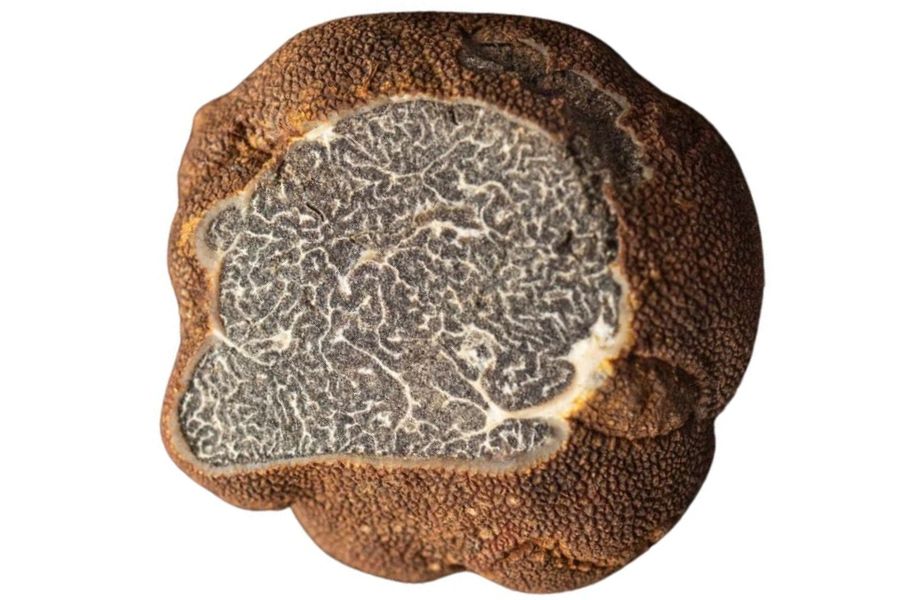South Carolina’s forests hold more than most people realize. Beneath the surface, wild truffles grow quietly in the shadows of trees, waiting to be found by someone who knows where to step.
They thrive in hardwood glades with soft soil and thick organic matter. Hillsides, streambanks, and older upland slopes often hold the right mix.
The search is not like spotting a mushroom on a trail. It’s slower, more deliberate, and often comes with false starts.
Even a single truffle feels like something earned. If you find the right ground, it might not even be the only thing you’ll bring home.
What We Cover In This Article:
- What Wild Truffles Look Like
- Truffle Lookalikes To Avoid
- Best Practices For Finding Truffles
- Where You Can Find Truffles Around The State
- Other Great Locations For Truffles
- When The Best Time Of The Year Is To Find Truffles
- The extensive local experience and understanding of our team
- Input from multiple local foragers and foraging groups
- The accessibility of the various locations
- Safety and potential hazards when collecting
- Private and public locations
- A desire to include locations for both experienced foragers and those who are just starting out
Using these weights we think we’ve put together the best list out there for just about any forager to be successful!
A Quick Reminder
Before we get into the specifics about where and how to find these plants and mushrooms, we want to be clear that before ingesting any wild plant or mushroom, it should be identified with 100% certainty as edible by someone qualified and experienced in mushroom and plant identification, such as a professional mycologist or an expert forager. Misidentification can lead to serious illness or death.
All plants and mushrooms have the potential to cause severe adverse reactions in certain individuals, even death. If you are consuming wild foragables, it is crucial to cook them thoroughly and properly and only eat a small portion to test for personal tolerance. Some people may have allergies or sensitivities to specific mushrooms and plants, even if they are considered safe for others.
The information provided in this article is for general informational and educational purposes only. Foraging involves inherent risks.
What Wild Truffles Look Like
The U.S. is home to several native truffle species that grow wild in forests across the country. Each one has its own unique scent, appearance, and preferred habitat. Here are the types of truffles you can find:
Oregon Black Truffles (Leucangium carthusianum)

Leucangium carthusianum, also called the Oregon black truffle, grows in the Pacific Northwest and usually shows up around Douglas-fir trees. It’s a native species and one of the more well-known edible truffles from the region.
On the outside, it looks like a small lump of coal—dark black, kind of lumpy or warty, and sometimes slightly smoother in spots. They’re usually about the size of a golf ball, but they can be smaller or larger depending on the season.
Inside, the truffle is firm with a marbled pattern of gray and white veins running through it. When it’s fresh, it smells fruity, almost like pineapple, but the scent gets stronger and muskier as it ripens.
If you’re out looking for them, check in moist, shady forests with soft, loamy soil, especially where there’s a lot of moss or ferns. They grow just below the surface, so people often use trained dogs to help sniff out the ripe ones.
Compared to the Oregon white truffle, which is lighter in color and has a sharper, garlicky aroma, the black truffle has a deeper, more earthy smell. It’s also bigger and firmer than the southern U.S. truffles like Tuber lyonii, which tend to be smaller, paler, and grow around hardwoods like oaks and hickories.
Oregon Winter White Truffles (Tuber oregonense and Tuber gibbosum)
Oregon has two native white truffles that are starting to get more attention: the Oregon Winter White Truffle (Tuber oregonense) and the Oregon Spring White Truffle (Tuber gibbosum). They grow underground in forests and are prized for their strong, savory aroma.
From the outside, these truffles are small, roundish, and kind of bumpy, usually pale beige to light brown. Cut one open, and you’ll see a white interior that darkens with age, showing off a web of white veins when it’s fully mature.
The Winter White Truffle pops up from late fall into February, while the Spring White starts showing up around January and can last into June. They’re pretty similar, but the Winter variety is known for having a more powerful scent and flavor.
To find them, you’ll want to look in forests with younger Douglas-fir trees on the west side of the Cascades. Truffle hunters often check for loose soil or spots where animals have been scratching, which can be a sign there’s something below.
When fully ripe, both types give off a bold smell that’s often compared to garlic, cheese, or earthy spices. They’re usually served raw, shaved over dishes to add that truffle kick without losing any of the aroma.
Appalachian Truffle (Tuber canaliculatum)
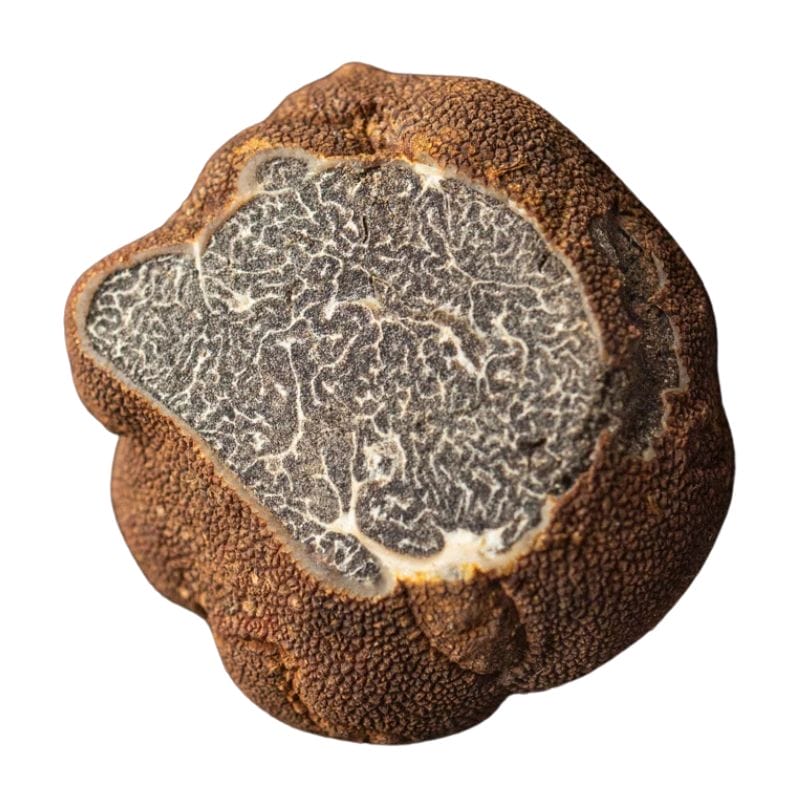
The Appalachian truffle, also known as Tuber canaliculatum, is a native North American truffle that’s slowly getting noticed. It’s about the size of a walnut and has a reddish-brown, bumpy outer surface that looks kind of like a rough, warty potato.
When you cut it open, the inside is firm and dark brown with thin white veins running through it like a marbled pattern. If it’s fully ripe, the smell is strong and earthy—some say it has a kind of nutty, funky aroma that stands out.
You can find these truffles in mixed hardwood forests, especially around oaks and pines, from late summer through fall. They grow underground, so look for spots where the soil is loose and animals like squirrels have been digging—sometimes that’s a good clue.
If you’re foraging, gently raking the top layer of soil near tree roots can help, but a trained dog or even a good nose makes it way easier. Once you know what to look for, the reddish color and bumpy skin are good signs you’ve found the right thing.
Compared to truffles like Tuber oregonense or Leucangium carthusianum, Tuber canaliculatum is more subtle in every way. Its smaller size and lighter scent mean you have to pay closer attention when foraging.
It’s also not as popular in the culinary world because it doesn’t pack the same punch in terms of flavor or aroma. Still, finding one can be rewarding, especially if you’re exploring different types of fungi in the area.
Desert Truffle (Terfezia and Tirmania spp.)
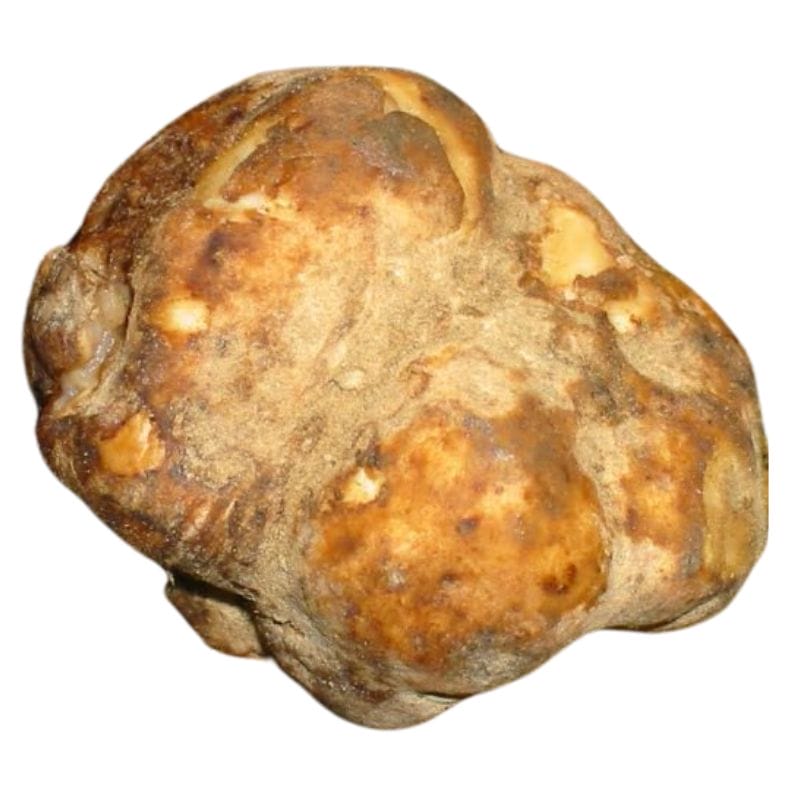
Terfezia and Tirmania are two types of truffles that are sometimes called desert truffles. These are a bit different from the truffles we usually think of, with their bold flavors and rich aromas.
These ones are a little more understated, but they’re fascinating in their own right. What makes them stand out is their ability to thrive in dry, harsh environments where you wouldn’t expect something so delicate to grow.
Unlike the earthy, intense aroma of black or white truffles, Terfezia and Tirmania truffles have a milder scent and flavor. They’re often described as nutty, with a hint of sweetness, but they lack the strong garlicky or musky notes you might associate with other truffles.
Their texture is also different—more firm and less oily than what you’d find with species like Tuber oregonense. They might not have the same culinary punch, but they’re still prized in traditional dishes, where their subtle flavors shine in simpler recipes.
When it comes to appearance, they’re easy to spot once you know what you’re looking for. They’re round to slightly irregular in shape, and their color can range from light beige to a reddish-brown, depending on the species.
The surface is usually smooth or slightly textured, without the rough, knobby look of a black truffle. Cut one open, and you’ll see a pale interior that’s often uniform in color, lacking the intricate veining you’d see in something like Leucangium carthusianum.
Pecan Truffle (Tuber lyonii)
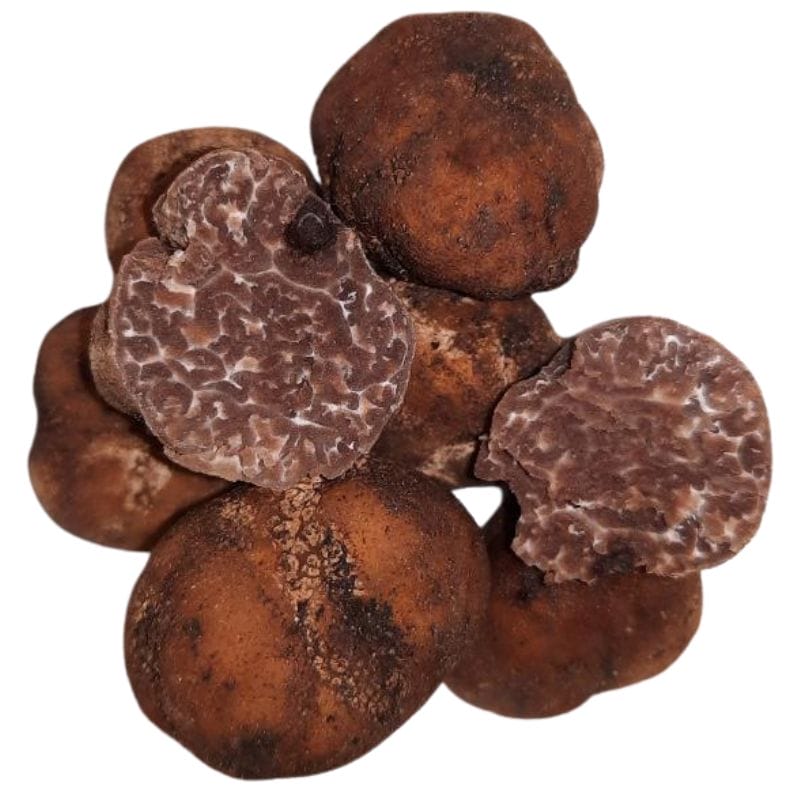
Tuber lyonii, also known as the pecan truffle, is a native North American truffle that grows underground near the roots of pecan trees. You’ll mostly find it in the southeastern U.S., especially in states like Texas, Georgia, and Mississippi.
On the outside, pecan truffles are round to lumpy and have a smooth, light brown skin that darkens as they age. They’re usually about the size of a marble or golf ball, and sometimes they even poke up slightly through the soil surface.
If you slice one open, the inside has a pretty marbled look—light tan streaks mixed with darker brown, almost like wood grain. The smell is earthy, nutty, and kind of warm, especially when they’re fully mature.
When you’re out looking for them, check under mature pecan trees or other hardwoods like oaks and hickories. Trained dogs can help sniff them out, but people sometimes spot them by looking for little cracks in the soil or raised areas near the tree’s base.
Compared to other U.S. truffles like the Oregon white truffle or the Appalachian black truffle, pecan truffles have a milder flavor and are more common in orchards. They’re a solid option in the kitchen—freshly sliced over pasta or mixed into butter—and they don’t come with the high price tag of their European cousins.
Truffle Lookalikes To Avoid
When you’re out hunting you also need to know about a few different fungi species that look very similar to the delicious truffles we’re after but are either inedible or not worth eating. Keep an eye out for:
Pine Truffles (Geopora cooperi)
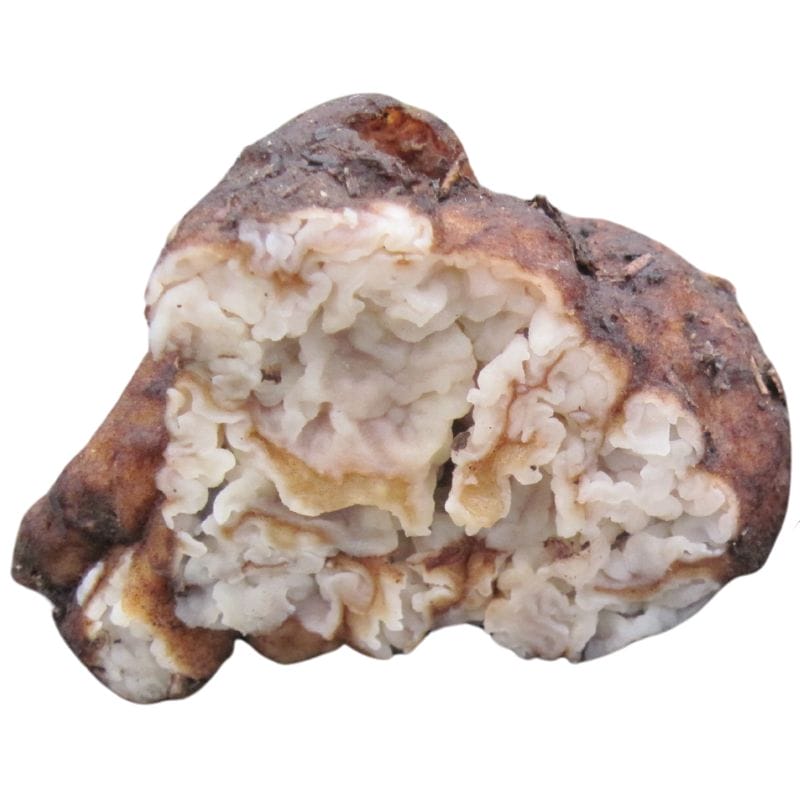
Geopora cooperi is a fungus that can easily confuse someone new to truffle hunting. It’s sometimes called the pine truffle because it grows underground like a true truffle and often pops up near certain trees.
At first glance, it might seem like you’ve hit the jackpot, but this one is a false truffle, not something you’d want to eat or sell.
The easiest way to tell Geopora cooperi apart from real truffles is by looking closely at its structure. While true truffles have a smooth or slightly knobby exterior and a marbled interior, Geopora cooperi has a rougher, more irregular outer surface.
When it matures, it sometimes splits open, revealing a cup-like shape, which true truffles never do. Inside, it’s less dense and doesn’t have the intricate veining that makes real truffles so unique.
Another big difference is the smell. True truffles have a strong, rich aroma that’s earthy, sweet, or garlicky, depending on the species. Geopora cooperi, on the other hand, has a much weaker scent, and it’s not as pleasant or distinctive.
If you’re relying on aroma to identify your find, this one will give itself away pretty quickly. So, while it might look similar at first, a closer inspection will show it’s not the culinary treasure you’re hoping for.
Stinking Slime Truffle (Melanogaster ambiguus)
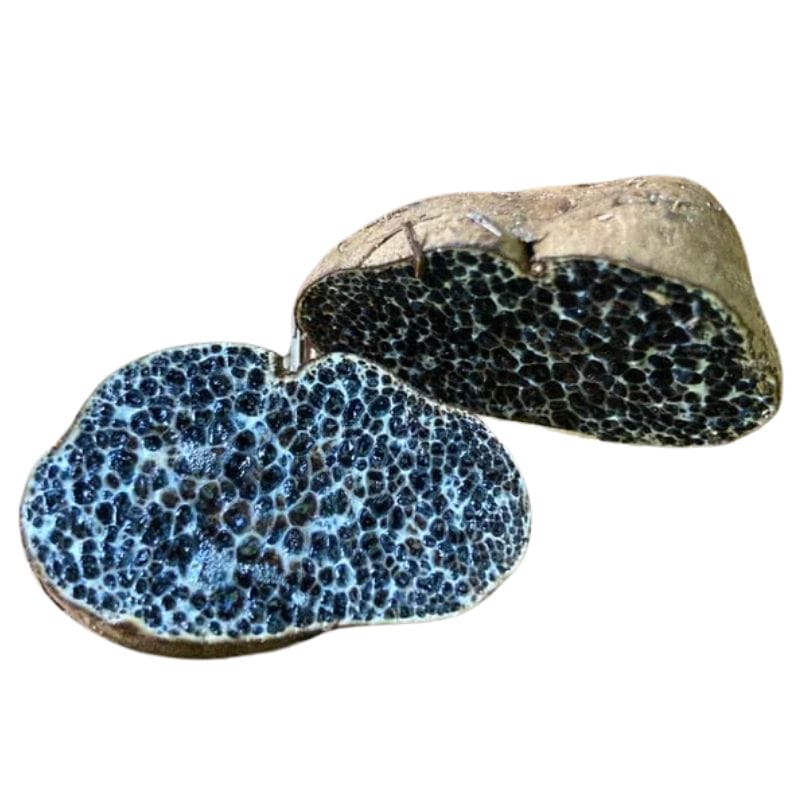
Melanogaster Ambiguus, because of their reddish-brown to dark brown exterior, might look like true truffles at first glance, but they’re quite different when you know what to look for.
The key difference is on the inside. When you cut open Melanogaster ambiguus, the interior is filled with flattened cells that have a shiny black gelatinous feel to them. Real truffles, on the other hand, have those beautiful marbled veins running through their flesh, almost like a web.
Another giveaway is the smell. While real truffles have a rich, earthy aroma that’s mouthwatering, Melanogaster ambiguus tends to have a much stronger, almost unpleasant odor—it’s not something you’d want to sprinkle on your pasta.
Earthballs (Scleroderma)
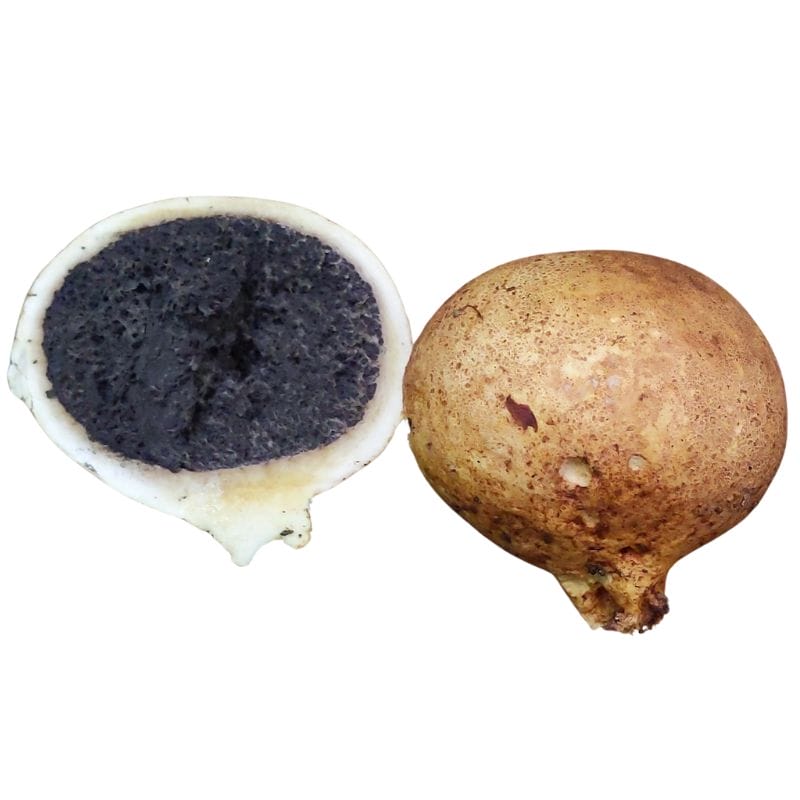
Scleroderma, commonly called earthballs, can easily fool someone who’s just starting out because they grow underground and have a round shape similar to truffles. But don’t be tricked—Scleroderma is not a true truffle, and it’s actually toxic, so it’s important to know how to tell the difference.
The first thing you’ll notice is the outer skin, which is thicker and tougher than that of most truffles. It can range in color from yellowish to dark brown, often with a rough or cracked texture.
If you cut it open, the difference becomes even clearer. While true truffles have a marbled interior with delicate white veins, Scleroderma starts out with a whitish inside that quickly darkens as it matures, turning black or purple with no marbling. It’s dense and solid, almost like charcoal in the later stages.
Another big giveaway is the smell. True truffles have a rich, earthy aroma that makes them so prized, while Scleroderma has little to no pleasant scent—some even describe it as musty or unpleasant.
Deer Truffles (Elaphomyces)
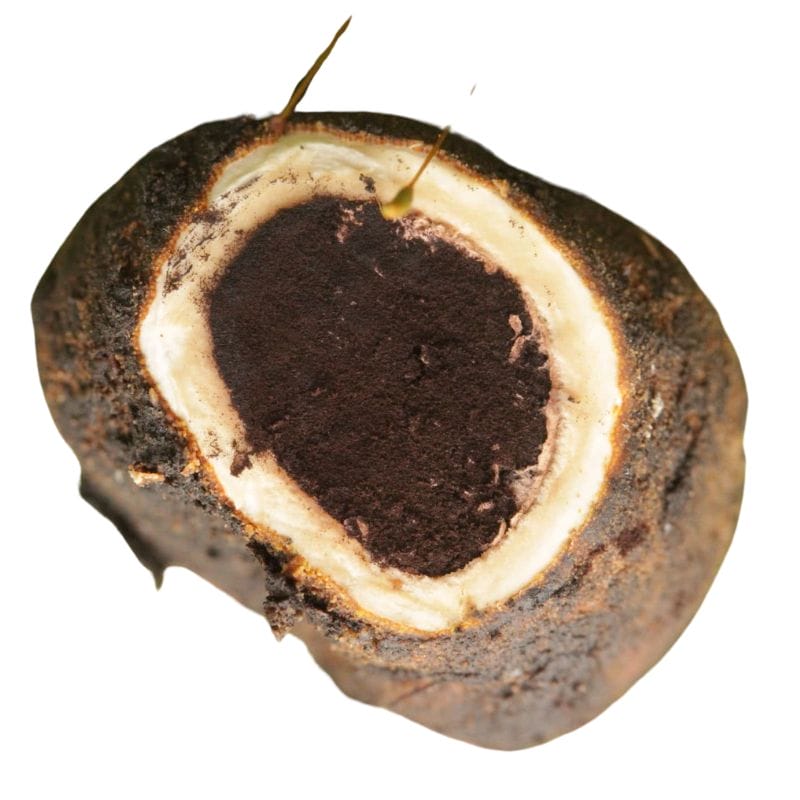
Elaphomyces, also known as deer truffles, look like true truffles at first glance, but they’re a whole different story. They’re called deer truffles because wildlife, especially deer and rodents, love to eat them. For us humans, though, they’re not edible—and definitely not what you want to mistake for a prized truffle.
Here’s how you can tell Elaphomyces apart from the real thing. First, they have a tough, warty outer surface that can range from pale tan to black, depending on the species and their age.
When you cut them open, the inside is solid and sometimes speckled or marbled, but not in the delicate, vein-like pattern you’d see in true truffles.
Their smell is also a big giveaway. Instead of the rich, earthy aroma of an edible truffle, Elaphomyces either has little scent or an odor that’s earthy but not particularly appealing.
Another thing to know is that Elaphomyces often grows deeper in the soil than true truffles, and they tend to have a harder, woodier texture.
Best Practices For Finding Truffles
Truffle hunting can be a rewarding adventure if you know the right tips and tricks. Here’s what you should keep in mind to improve your chances of finding these underground treasures:
Wait 10 to 14 Days After Heavy Rain
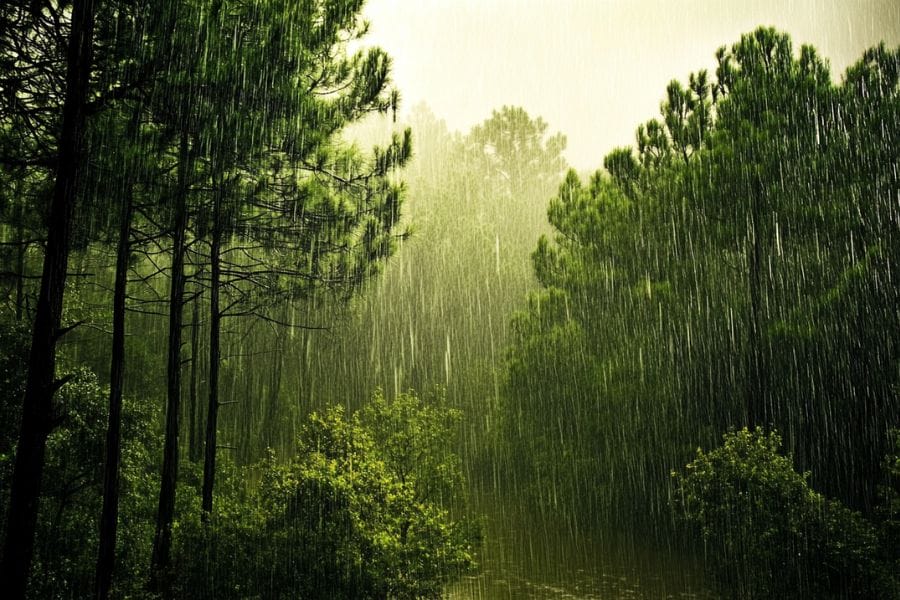
After a heavy rain, it’s best to wait about 10 to 14 days before heading out. This gives the truffles time to mature and release their signature aroma, making it easier for you (and your dog) to sniff them out. Rain helps truffles grow, but they don’t start giving off their scent right away.
As the soil warms up, the truffles get more aromatic, and the ground becomes looser, which makes digging easier without disturbing the environment too much. The timing is perfect to find truffles at their best—both in quality and in how easy they are to locate.
Find the Right Trees
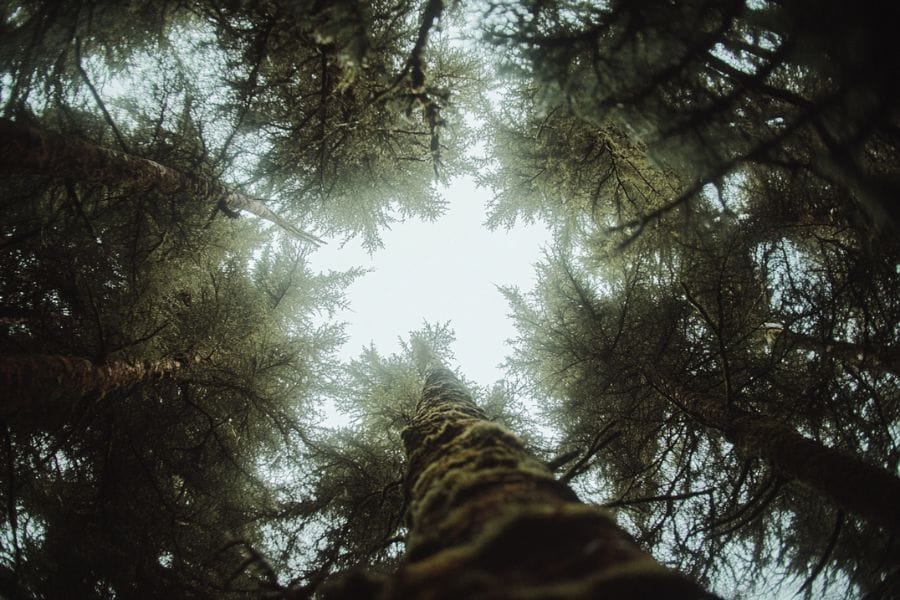
Truffles don’t grow just anywhere—they have a special relationship with certain trees. You won’t find them under just any tree, so knowing which ones to look for can make all the difference. Some of the best trees to look out for are:
- Pines
- Douglas-firs
- Oaks
- Hazelnuts
- Cypresses
- Willows
For example, if you’re looking for Oregon white truffles, keep an eye out for Douglas-fir trees. California black truffles, on the other hand, are often found near oaks and hazelnuts. The soil around these trees also needs to be slightly alkaline, so it helps to know what kind of ground you’re walking on as well.
Watch for Wildlife Activity
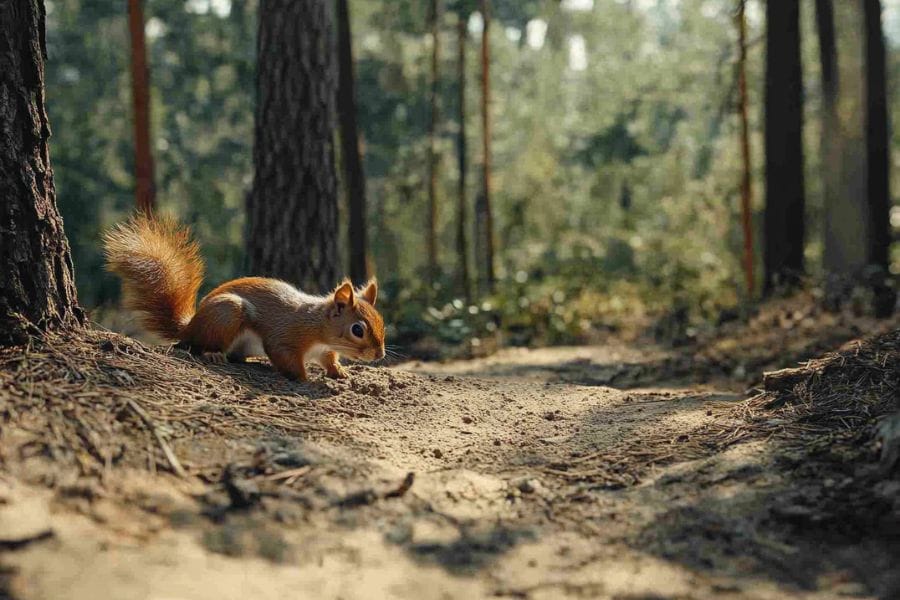
Animals like squirrels and chipmunks often help spread truffle spores, and sometimes their digging can lead you straight to truffles. While you won’t always find truffles in every pit animals dig (they also look for things like acorns or bulbs), fresh digs are a good clue. The more recent the pit, the better chance it has of leading to truffles.
Even though animals are a part of the truffle cycle, most hunters prefer using dogs to find the real treasure underground. Dogs have an incredible nose for truffles and can pinpoint their location much more reliably than any squirrel or chipmunk.
Get a Little Help from a Truffle-Hunting Dog
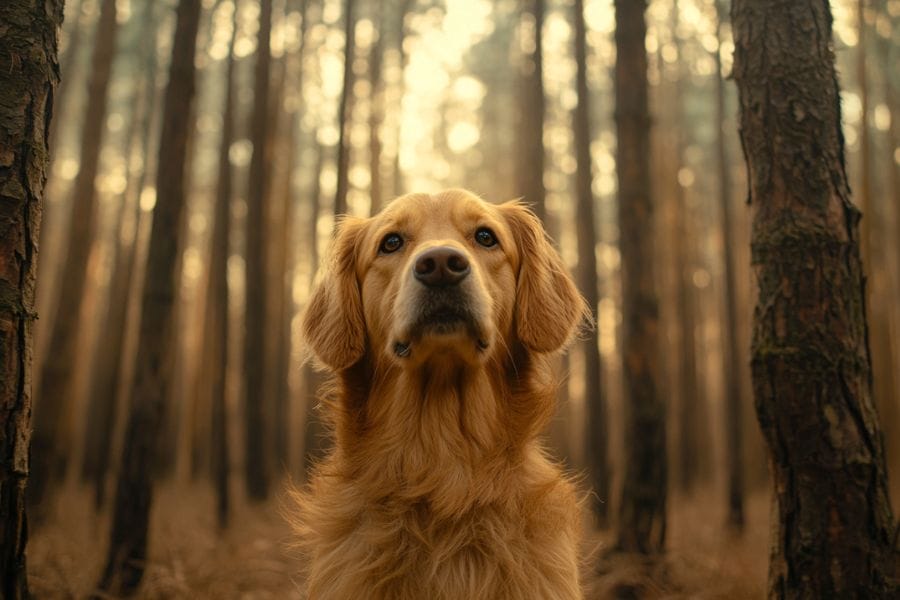
If you’re serious about truffle hunting, a trained dog can make your life a whole lot easier. Their sense of smell is extraordinary, and they’re trained to find mature truffles buried beneath the surface. Many truffle hunters swear by their dogs, and for good reason—they’re much more accurate than humans when it comes to sniffing out truffles.
If you don’t already have a trained dog, you can connect with local foraging groups or specialized trainers who offer truffle-hunting services. Some places even host events where you can see experienced handlers with their dogs in action. And if you’re feeling adventurous, you can train your own dog using truffle-scent kits and practice in a controlled space before hitting the woods.
Before you head out
Before embarking on any foraging activities, it is essential to understand and follow local laws and guidelines. Always confirm that you have permission to access any land and obtain permission from landowners if you are foraging on private property. Trespassing or foraging without permission is illegal and disrespectful.
For public lands, familiarize yourself with the foraging regulations, as some areas may restrict or prohibit the collection of mushrooms or other wild foods. These regulations and laws are frequently changing so always verify them before heading out to hunt. What we have listed below may be out of date and inaccurate as a result.
Where You Can Find Truffles Around The State
Now we’re going to go over five of the best locations for finding truffles. We’ll go a bit in-depth here and then provide a much longer list of other spots to try.
Sumter National Forest
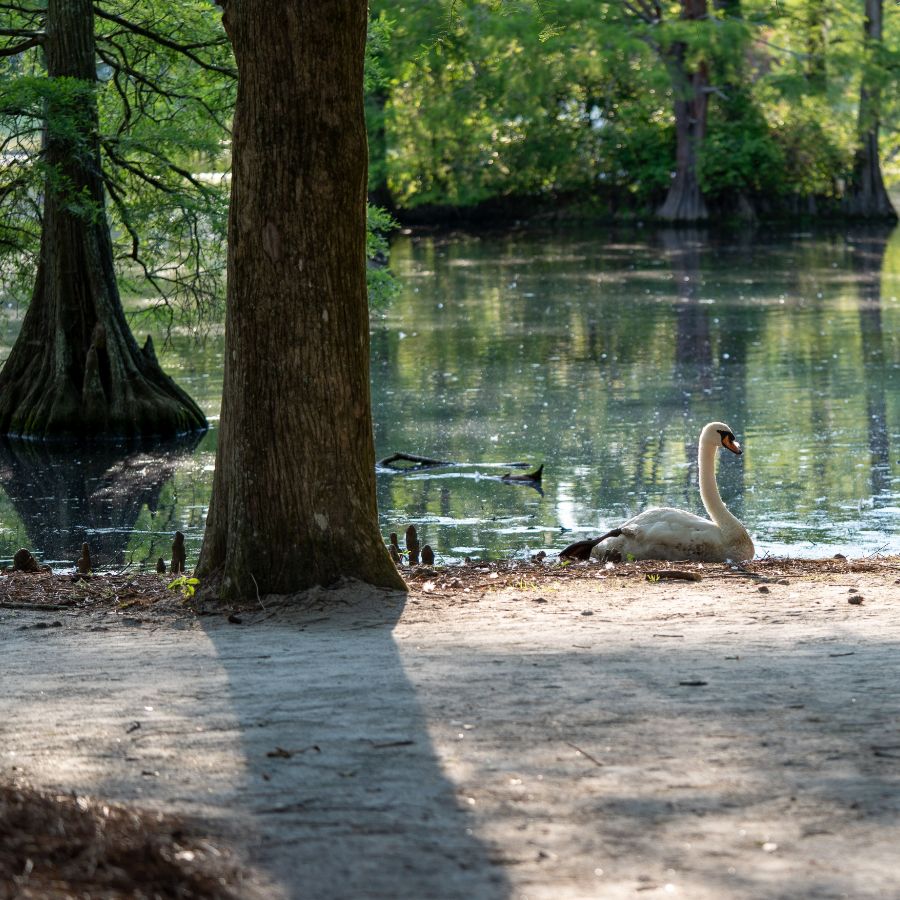
Sumter National Forest contains the highest waterfall in South Carolina within its borders—Raven Cliff Falls. The surrounding forest around the Chattooga Scenic River area stretches over rugged foothills, and that same elevation shift fosters truffle growth under mixed hardwoods and thick mountain soil.
Near Fork Mountain Trail in the northwest section, you’ll pass through old patches of oak and hickory that are rarely cleared and hold plenty of mycelium-rich ground cover. In late summer, the dense organic matter here supports fungal life just below the surface, including truffle species tied to those older trees.
Along the Broad River in the eastern district, there are quieter bottomlands where deer trails cut through beech groves and scattered sycamores. The forest floor in these spots stays undisturbed, with thick natural compost that supports underground fungi.
To the south, sections of the Long Cane Ranger District that border McCormick have isolated pockets of upland oak stands. Between those ridges, the soil stays loose and shaded enough for truffles to survive near decaying roots and fallen limbs.
Francis Marion National Forest
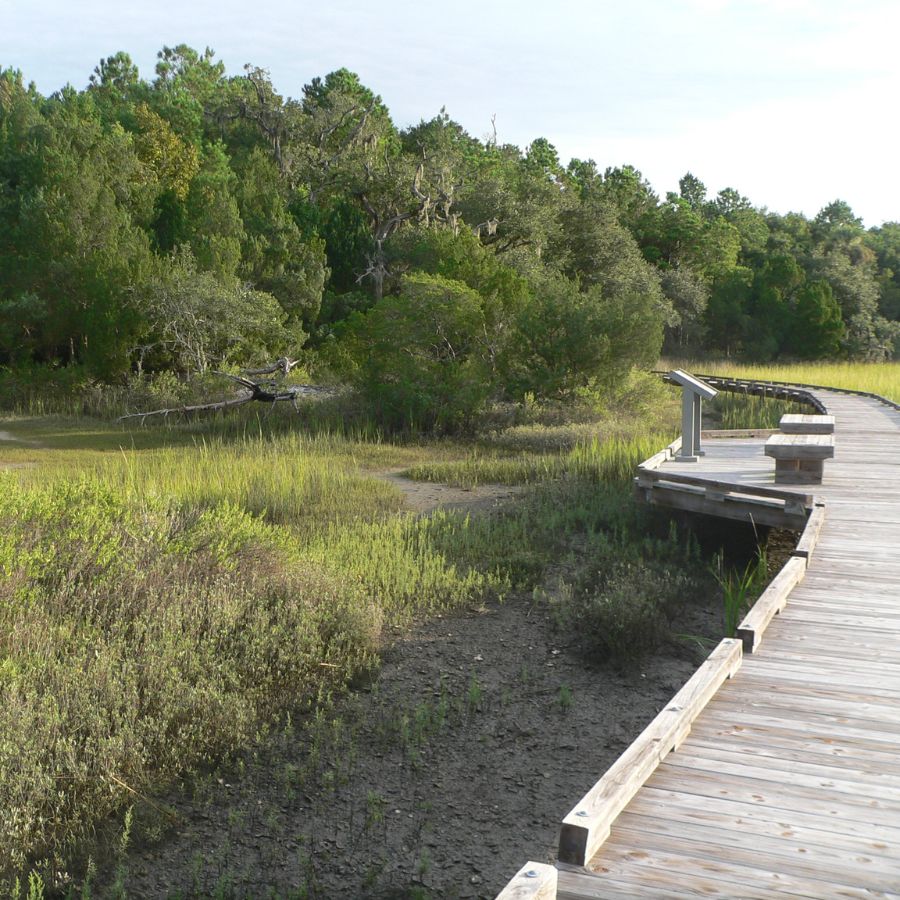
Francis Marion National Forest is home to one of the largest protected longleaf pine ecosystems on the eastern seaboard. Around the inland edges near Witherbee, the pine canopy thins just enough to let light reach the understory where truffle-producing fungi coexist with clumps of blackjack oak.
If you follow the I’on Swamp Interpretive Trail, you’ll move through dense groves of laurel oak and red maple that line the old wetland basin. The soft rise in elevation along some parts of the trail leads into slightly drier hummocks, where the ground supports fungal growth beneath mature hardwoods.
North of Highway 45, the Wambaw Cycle Trail cuts through a more isolated patch of forest that hasn’t been heavily disturbed. When the trail hugs closer to Turkey Creek, you can see the accumulation of natural debris around the base of old trees where truffles are often present.
Between Echaw Road and Battery Warren, a stretch of older forest lies in relative quiet next to the Santee River. That part of the forest is shaded by overstory trees with thick mats of leaf litter, creating a consistent environment for truffles beneath oak and hickory.
Paris Mountain State Park

Paris Mountain State Park is one of the oldest protected natural areas in the state park system, having been built up by the Civilian Conservation Corps in the 1930s. On the east side of the park, the stretch between the Bracken Preserve and North Lake Trail includes hardwood pockets where wild truffles can be found in the damp soil near chestnut oak and sourwood.
Following the Mountain Creek Trail, you’ll notice how the lower sections dip into shaded draws that rarely dry out. These protected hollows provide just the right depth of leaf buildup for truffle-producing fungi to thrive among the roots.
Up on Reservoir 3 Trail, the terrain levels out and becomes quiet, with long runs of forest away from foot traffic. Along the west side of the loop, you’ll find patches of old pine mixed with oak and beech, where the ground tends to stay soft and undisturbed enough for truffles to grow.
Toward the southern border of the park near Altamont Road, the elevation begins to taper and the trees become more spaced out. In some of those gaps, the soil is broken by older tree roots and natural debris, creating conditions that have supported truffles in other parts of the forest.
Table Rock State Park
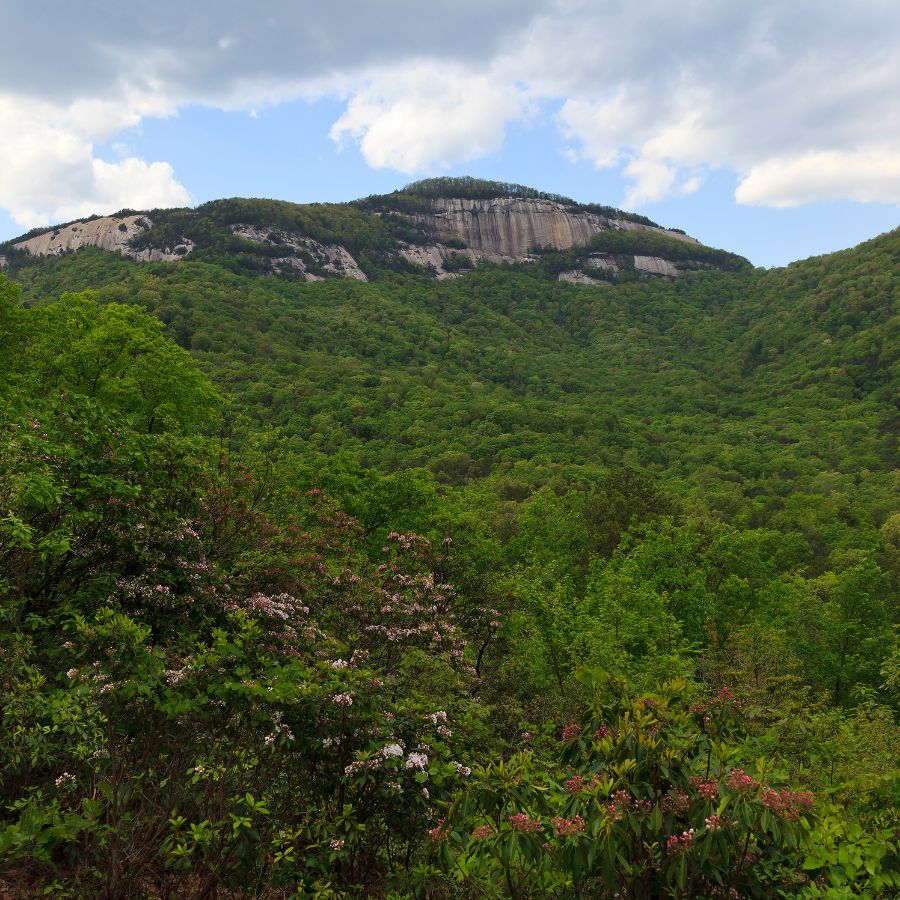
Table Rock State Park includes more than 3,000 acres of forest, creeks, and trails at the edge of the Blue Ridge Escarpment. Just above the Nature Center, the forest thins briefly before descending toward a stream where truffles often develop under oak and hornbeam.
The west side of the park near the Ridge Trail offers a mix of elevation and vegetation that shifts quickly over short distances. In the hollows between small climbs, you’ll come across pockets of damp loam where truffles grow beneath tangled tree roots.
Near the edge of Lake Pinnacle, the shoreline transitions into a narrow wooded trail leading up toward the rock wall base. On that uphill slope, truffles tend to occur in places where the forest floor is dense with decomposing leaves under thick beech cover.
The Mill Creek section near the Foothills Trail junction receives little foot traffic but stays shaded and humid for most of the year. That stretch of trail curves around moss-covered rocks and older hardwoods, both of which signal ground conditions favorable to truffle-producing fungi.
Caesars Head State Park
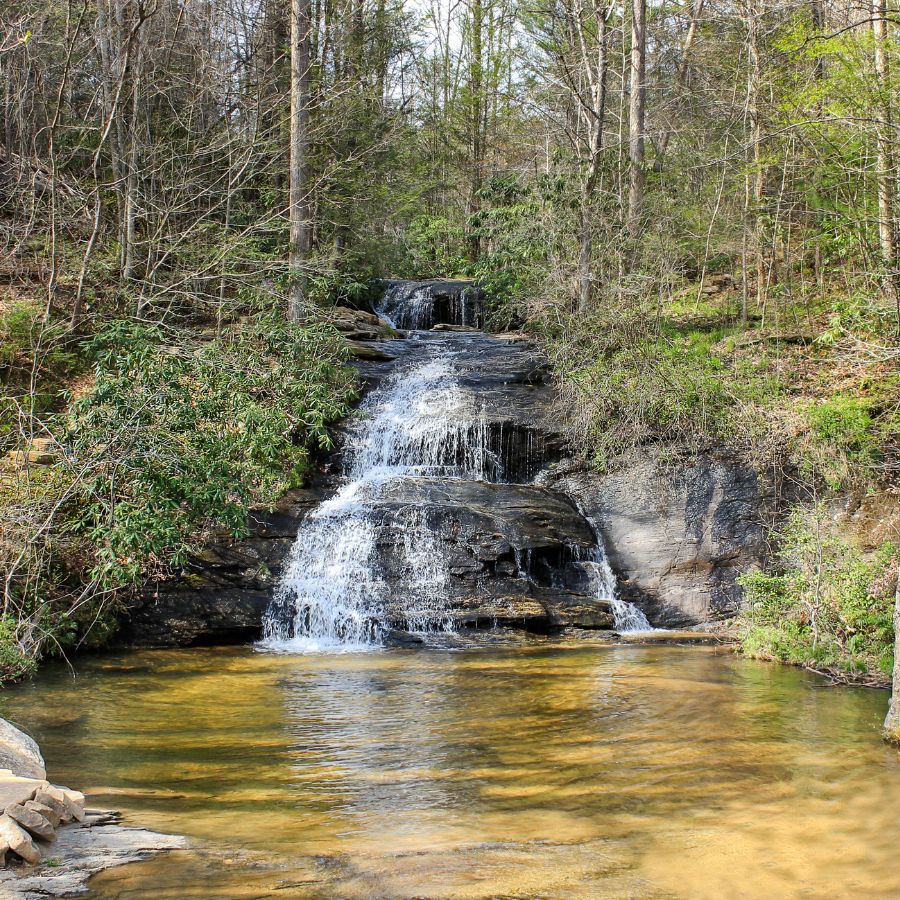
Caesars Head State Park offers one of the highest viewpoints in South Carolina, with its overlook perched more than 3,000 feet above sea level. Downhill from the overlook, the trail to Raven Cliff Falls cuts through old-growth hardwoods, and in the cooler hollows near the bridge crossings, truffles have been found beneath layers of damp oak leaves.
Along the Gum Gap Trail, the terrain varies between ridgeline pine and low-lying hardwood pockets. In one of the shallow draws near the split with Naturaland Trust Trail, moisture collects under a canopy of maple and hickory where truffle-producing fungi are commonly supported.
The Frank Coggins Trail loops through quieter parts of the forest just west of the main visitor area. In sections where the path flattens near streambeds, you’ll notice dense tree cover and deep leaf litter that support underground fungi including truffles.
Toward the north end of the park, just above the state line, the trail system winds through secluded woods fed by small unnamed creeks. On the slopes leading into those drainages, truffles tend to occur around well-established hardwoods rooted in loamy soil.
Other Great Locations For Truffles
The following locations offer additional opportunities to find wild truffles in hidden corners of the state:
| Coastal Plain | What’s allowed & why it’s good truffle ground |
| Francis Marion National Forest | Moist oak flats under pine canopy; USFS permits low-impact foraging. |
| Beaufort County | Maritime forests on barrier island edges grow truffles in shaded oak hammocks. |
| Hunting Island State Park | Dense coastal woodlands with natural mulch layers; personal hand-foraging allowed on trails. |
| Beaufort City | Urban greenbelts with historic oak clusters; fungi emerge after rains in shaded lawn edges. |
| Lake Warren State Park | Hardwood clusters along lake edge create damp zones; permitted foraging within main park forest. |
| Midlands | What’s allowed & why it’s good truffle ground |
| Manchester State Forest | Longleaf–oak mix with loamy ground; SCDNR allows personal-use foraging on foot. |
| Poinsett State Park | Older upland hardwoods near shallow drainages; quiet zones allow walking foraging. |
| Chester County | Clay-loam uplands with mixed timber; foraging allowed on public walking land. |
| Fairfield County | Lightly used woods with oak–gum cover; pockets of shade create fungal zones. |
| Newberry County | Upland pine–oak blend with good duff buildup; personal-use foraging permitted. |
| Edgefield County | Riverbluff hardwoods near national forest border; ground truffles favored. |
| Laurens County | Older tree lines and forest breaks; hand foraging generally permitted. |
| Greenwood County | Oak-rich uplands near Enoree River; small truffles often near root clusters. |
| Enoree River Area | Floodplain edges host fungi under gum and maple; quiet zones open for hand foraging. |
| Tyger River Area | Riverbanks with oak-hickory mix stay damp; no permit needed for personal-use foraging. |
| Broad River Area | Leaf-rich slopes near trail systems; fungi fruit in deep shade along bends. |
| Mill Creek Area | Shaded pockets between ridges and pasture edges give light cover where truffles grow. |
| Sumter County | Older pine–oak stands near creeks; scattered public lands allow walking foraging. |
| Lee State Park | State-managed bottomland hardwoods; fungi thrive in soft soil under laurel oak. |
| Columbia County | Mixed forest corridors with heavy canopy cover; legal foraging allowed in designated zones. |
| Richland County | Creekside hardwoods retain leaf duff; truffles appear along quiet public park areas. |
| Lexington County | Undeveloped parcels near pine–oak groves hold moisture and allow foraging without restriction. |
| Harbison State Forest | Managed woodlands west of Columbia; SCDNR permits allow personal truffle foraging on foot. |
| Hitchcock Woods | Historic public forest with sandy loam trails; fungi occur in oak-rooted swales. |
| Sand Hills State Forest | Wiregrass and pine with oak breaks support summer truffles; legal to forage on non-posted trails. |
| Congaree National Park | Old-growth bottomland with sustained humidity; foraging allowed in upland sections by foot. |
| Santee State Park | Mixed hardwood stands beside the lake; ground fungi fruit near water oak and loblolly. |
| Upstate | What’s allowed & why it’s good truffle ground |
| Sumter National Forest | USFS allows hand foraging for personal use; oak–hickory slopes hold summer truffles. |
| Paris Mountain State Park | Beech–oak hills retain moisture; state parks allow low-volume hand collection. |
| Caesars Head State Park | Mountain coves along trail corridors; shaded roots hold spring truffles. |
| Devils Fork State Park | Rich cove forest above Lake Jocassee; deep duff supports underground fungi. |
| Keowee-Toxaway State Park | Mixed oak ridges along the foothills; truffle habitat beneath leaf litter. |
| Oconee State Park | High-elevation hardwoods in sheltered hollows; state land permits light foraging. |
| Jones Gap State Park | Moist ravines under mature canopy; trail-accessible areas host fungi. |
| Table Rock State Park | Shaded oak slopes and leaf buildup near creeks; state park trails cross key spots. |
| DuPont State Recreational Forest | Hardwood forests with year-round moisture; border access ok under NC foraging law. |
| Gorges State Park | Deep escarpment woods with mossy cover; NC state law allows fungi hand-picking. |
| Paris Mountain (Town) | Residential greenbelts and wooded lots have truffle-friendly soils. |
| Greenville County | County parklands with oak woods permit limited foraging with foot traffic. |
| Spartanburg County | Scattered hardwood zones near creeks; not restricted for low-impact personal foraging. |
| Union County | Rolling oak groves near forest edges; fungi common near older trees. |
| Abbeville County | Rural forest patches with mature oaks; legal access on non-posted public land. |
| McCormick County | Pine transition zones next to Sumter; scattered hollows fruit truffles in summer. |
| Oconee County | Forested slopes with old oak groves; non-posted public lands allow casual foraging. |
| Pickens County | Moist hardwood draws near foothills; scattered truffles form under undisturbed cover. |
| Clemson Experimental Forest | Managed oak–pine woods west of campus; low-impact foraging permitted on designated tracts. |
| Headwaters Area | Near the escarpment border; high-humidity hollows shelter summer truffles. |
| Croft State Park | Shaded hillsides and hidden ravines; park rules allow low-impact foraging in forest zones. |
| Kings Mountain State Park | Oak-maple forests just below the ridge; ground fungi present near backcountry trails. |
When The Best Time Of The Year Is To Find Truffles
The best time to hunt for truffles in Florida typically falls during the cooler months, from late fall to early spring. These months provide the right combination of moisture and moderate temperatures for truffle growth.
After a period of heavy rain, waiting 10-14 days allows the soil to stabilize and the truffles to mature, enhancing their aroma. Focus on mornings or cool, overcast days to improve conditions for foraging, as truffle scent is more pronounced in cooler, damp environments.
Seasonal timing is key, as Florida’s warm, humid climate can impact truffle availability outside of these optimal months.
One Final Disclaimer
The information provided in this article is for general informational and educational purposes only. Foraging for wild plants and mushrooms involves inherent risks. Some wild plants and mushrooms are toxic and can be easily mistaken for edible varieties.
Before ingesting anything, it should be identified with 100% certainty as edible by someone qualified and experienced in mushroom and plant identification, such as a professional mycologist or an expert forager. Misidentification can lead to serious illness or death.
All mushrooms and plants have the potential to cause severe adverse reactions in certain individuals, even death. If you are consuming foraged items, it is crucial to cook them thoroughly and properly and only eat a small portion to test for personal tolerance. Some people may have allergies or sensitivities to specific mushrooms and plants, even if they are considered safe for others.
Foraged items should always be fully cooked with proper instructions to ensure they are safe to eat. Many wild mushrooms and plants contain toxins and compounds that can be harmful if ingested.

